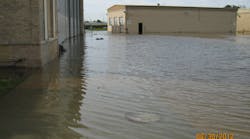Headquartered in Charleston, NC, Hawthorne's general aviation roots go back some 80 years.
Relates Hawthorne Global Aviation Services CEO, Steve Levesque, "For many years, we did what everyone else in the general aviation services industry did, which is really focus on flight operations and flight training."
That included training a lot of pilots during the war years of WWII and Vietnam. The Hawthorne company was a contractor for the military, at one point, training many Air Force pilots at Spence Airport Base in Georgia.
In the ‘80s, Hawthorne began to branch out geographically with different airport operations. Piedmont-Hawthorne, formed in 1998 and sponsored by the Carlyle Group, was an early incarnation.
Levesque joined Hawthorne in 1995 via the financial side of the business, leading the corporate development effort with Piedmont Hawthorne after the ’98 transaction, where the company started with 22 locations, then added another dozen or so in the three years after. Levesque became CFO at Piedmont Hawthorne/Landmark Aviation before leaving.
In 2007, professionals from the former Piedmont Hawthorne management team came back to reconstitute what had been left over from the 1998 transaction with Carlyle. "We’ve had different management contracts and worked in advisory and consulting, all with an eye to starting a new FBO effort," says Levesque.
In 2011, the group teamed up with Moelis Capital Partners, a private equity firm, for the FBO effort. That’s when the new FBO chain was born.
Creating Synergies
"Today our model really goes back to what I would call the old Hawthorne model — where our focus is not just on size," remarks Levesque. "We don’t want to become a big monolithic service provider where everybody is just an account member. We want to keep the spirit of customer service and a customer-centric focus in everything we do."
With some 250 employees, the company is focused on filling out its network and creating synergies on behalf of its customers.
With regard to FBO acquisition efforts, Levesque says Hawthorne has standards, but it’s not a hardline rule or one-size-fits-all approach, which is also how he describes the company's customer service philosophy.
"It’s very custom or bespoke to the customer," he says. "We like growth airports, or airports that are commonly referred to as second-tier. Obviously the biggest airports are the most expensive to get on; I don’t think we will be on all of those.
"We certainly like for every operation to take on the characteristics of the local community. We want to be professional and offer a certain service level, but we don’t want to make it look like a large corporate organization that’s one-size-fits-all. It’s a gateway to the local community, and we want the operation to reflect that."
According to Levesque, the company would like to, on average, add four to six operations each year, " ... and we would like to do that for a number of years, to come up with an old Hawthorne or AMR-sized chain that has a national footprint that brings and delivers synergies to its customers.
"We are opportunistic and it is a national campaign; we want to build out a network that is truly national."
On the technology side, one of the benefits of starting like Hawthorne did is that it's not burdened with any legacy systems or structures, or technology that isn’t up-to-date, explains Levesque. "We’ve got a great back office which is extremely responsive to the customer, and that’s part of the rebranding and re-training we do when we acquire a new FBO," he adds.
All FBOs Are Local
Hawthorne currently operates two locations: a facility in Long Island at MacArthur Airport, where its aircraft management and charter fleet is located; and an FBO at the New Orleans Lakefront Airport, an Aeropremier facility which Hawthorne purchased a controlling interest in earlier this summer.
"We like growth and the core retail fueling and core line service and hangarage business; that’s what we look to first and foremost, comments Levesque. "In terms of whether the airport is a Part 139 airport, or has commercial service, or different types of approaches, runway lengths, or even multiple FBOs … that’s all kind of situational. Each one is different and unique and has to be analyzed as such.
"Obviously, the longer term the lease, the more investment as an operator we can afford to make and realize over time. But we understand the airport’s point-of-view as well; it’s an interdependent relationship."
In terms of services, Hawthorne will do as demand warrants. All FBOs are local, to some extent, relates Levesque. "At MacArthur, we have our charter fleet, which we can expand nationally, and are … we recently added three aircraft. We also have a fairly good sized maintenance department at Islip, which is a Part 145 Repair Station. We are an Embraer service center, and we have a lot of other service designations as well, especially in avionics … not only for our fleet, but for the demand that’s in the local area."
The New Orleans operation is a line-centric FBO, but the company has the capability to bring other lines of business in.
"The things we probably don’t want to be in, because they require a certain scale, is flight training and engine overhaul," explains Levesque. "Those are kind of the two extremes on either end that we don’t see ourselves getting in to."
With regard to hangaring aircraft, Levesque says the company is fortunate to be full at both locations. In Long Island, Hawthorne is building a new 30,000-square foot hangar slated to open in 2013. The new facility will likely be BBJ (Boeing Business Jet) capable.
When it comes to fuel sourcing and brand preference, Hawthrone will be a Shell dealer at most locations. At New Orleans, the FBO provides Avfuel due to an agreement that was already in place.
As for fuel pricing, Levesque says it’s a dynamic that is really driven by the market. "For based customers, we obviously try to put together a value package that has pricing interaction between the hangar side and rent," he comments. "We certainly keep an eye on prices daily, but subject to extreme market conditions, we typically adjust prices weekly, if that."
Regarding aircraft activity, "I think we have been fortunate to be a little above the industry averages that we’ve seen," says Levesque. "I think we see what the rest of the industry does: it’s a single digit increase year-over-year for the last few years.
"The small and mid-sized jet activity hasn’t recovered as much as large cabins have, and that’s consistent with general industry trends.
On the charter side, Levesque says Hawthorne is typically a buyer’s agent, meaning, if someone wants to purchase an aircraft that they would like Hawthorne to manage, the company helps them in the pre-buy and purchase experience.
Currently, Hawthorne manages some 23 turbine engine aircraft. The business has been more cyclical than fuel, which historically is consistent with how charter tends to be, explains Levesque. "We’ve seen a lot more demand in the second half of this year than the first, which we think bodes well.
"It’s a great time. There is some economic uncertainty, but we like to long-term trends of the industry."




